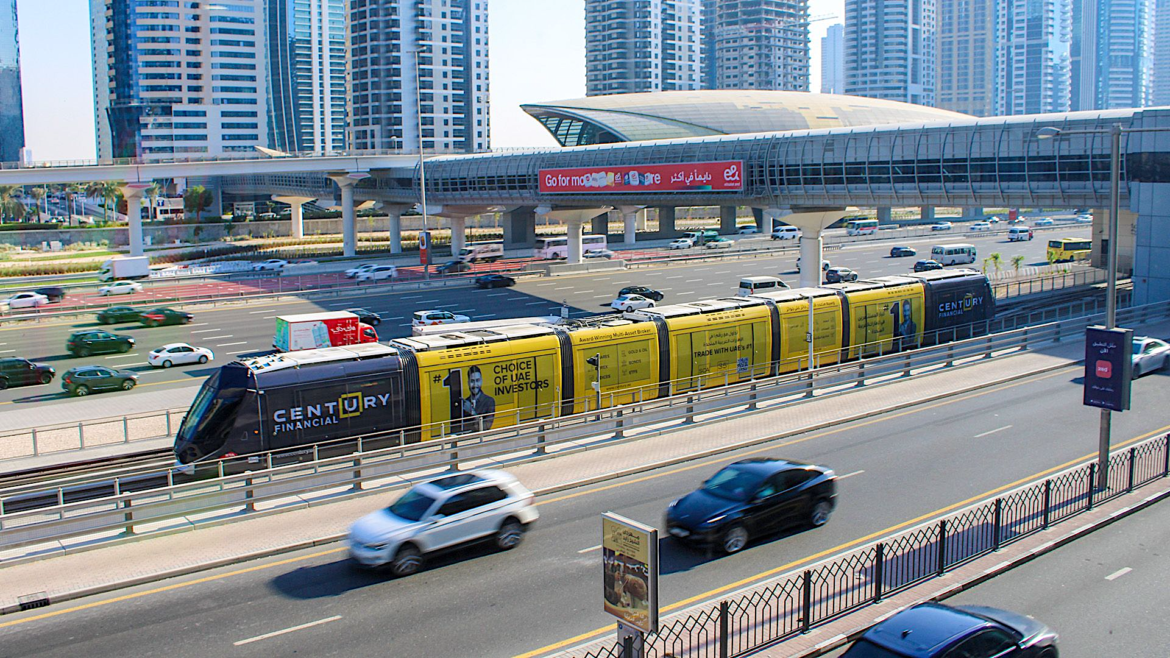By Staff Reporter
Monetizing Dubai’s Transit Hubs: Marketing to Commuters at Metro Stations and Airports
Every city has its heartbeat — and in Dubai, that rhythm flows through its metro stations and airport terminals. These spaces see millions of people every day, creating a steady stream of potential customers in moments when attention is naturally focused.
In 2024, Dubai’s public transport network recorded 747 million journeys, averaging over 2 million trips daily, with the metro accounting for more than a third. Dubai International Airport welcomed 92.3 million passengers the same year, with over 46 million in the first half of 2025 alone. Few advertising environments offer this kind of guaranteed, sustained exposure.
Beyond the numbers lies the real opportunity: commuters and travelers are often waiting, moving, or in decision-making mode. Airports host high-intent audiences, while metro stations offer daily, repetitive visibility. Together, they give brands a unique blend of mass reach and precise targeting, turning ordinary transit moments into powerful marketing touchpoints.
In this article, we’ll explore how businesses can strategically leverage these transit hubs to boost visibility, engagement, and measurable impact.
Understanding the Commuter Audience
When your campaign lives in transit hubs, your “audience” isn’t a monolith — it’s a mix of traveler types, each bringing their own mindset, motion patterns, and openness to messaging. To land meaningfully, brands must tailor to these nuances. Below is a breakdown of the major commuter groups and what their behavior offers marketers.
1. Daily Metro Users
Who they are
This group includes residents commuting to work or school, service employees, and regular users of public transport. The metro system is a backbone of daily mobility in Dubai.
State of mind & behavior
Routine & repetition: many take the metro at fixed times, often passing through the same stations daily.
Dwell moments: walking through concourses, waiting on platforms, entering/exiting.
Cognitive load: moderate — they’re attentive enough to notice visuals but not too distracted.
Mobile-ready: more likely to have phones ready to scan, click, or respond to calls-to-action.
Opportunity window
Use high frequency media (wraps, digital screens) to reinforce brand recall.
Place QR codes or short calls to action around exits or platform edges.
Time campaigns around rush-hour peaks (morning outbound, evening inbound).
2. Office/Business Commuters
Who they are
Professionals and executives traveling between home, business districts, and meetings— many via metro or integrated feeder transport.
State of mind & behavior
Time-sensitive mindset: they’re tuned to efficiency, meaning messages must be crisp and immediately valuable.
Focus on utility: offers, tools, services that save time, money, or enhance productivity resonate more.
Selectivity: less patient with noise — more receptive to clear, relevant, concise messaging.
Opportunity window
Use contextual creative: “Get to your meeting in style,” “Upgrade your workday,” etc.
Emphasize premium / time-saving propositions (services, apps, banking).
Prioritize placement near business-district stations.
3. Tourists & Occasional Metro Visitors
Who they are
First-time or infrequent users of the metro often navigate between attractions, hotels, malls, or transit points.
State of mind & behavior
Exploratory mood: open to discovery and offers because they’re out of their routine.
Higher dwell time in interchanges, in maps areas, information kiosks, and concourses.
Receptive to wayfinding support, local experiences, deals, and recommendations.
Opportunity window
Use orientational creative (e.g., “top things to see,” “local deals”).
Promote city passes, experiences, food, and transport apps.
Leverage media near maps, kiosks, and tourist info points.
4. Airport Travelers (Arrivals, Departures & Transit Passengers)
Who they are
A mix of business travelers, tourists, transit/connecting passengers, and local residents flying domestically or internationally.
State of mind & behavior
Elevated dwell times: check-in, security, immigration, lounges, boarding gates — many waiting periods.
Decision mode: travelers often make purchases (duty-free, food, services) while moving through terminals.
Receptivity to cross-selling: supplemental services (SIM cards, currency exchange, local telecom, hotel bookings) are highly relevant.
Opportunity window
Use large-format digital media in pre-security, duty-free, boarding zones.
Target arrival halls for onward mobility services (rides, local SIMs, tours).
Use sequential messaging: “Welcome to Dubai → Best things to do → Where to buy SIM / local deals.”
Metro Stations: Everyday Brand Exposure
Metro stations are more than transit points — they’re daily pathways that shape how people move through the city. For brands, this means regular, predictable exposure to hundreds of thousands of commuters, all within a structured environment designed for visibility.
One of the most powerful opportunities lies in station naming rights. When a company takes over a station name, it becomes woven into everyday conversation. Commuters hear it in announcements, see it on maps, and use it as a reference point for directions. Deals like Life Pharmacy’s 10-year naming of the UAE Exchange station or National Paints’ sponsorship of Jebel Ali demonstrate how brands can secure long-term visibility that goes far beyond traditional advertising.
Within the stations themselves, digital screens and LED panels light up concourses and corridors. These dynamic displays allow brands to run animated content or time-specific messages, keeping campaigns fresh and engaging throughout the day. Wall panels, escalator sides, and concourse placements work in tandem, catching attention as people pass through high-traffic zones like ticket halls and main walkways.
On the trains, full or partial wraps transform carriages into moving billboards, extending reach beyond station walls. Inside, branding on doors, overhead panels, and seatbacks keeps the message present during the ride itself, when commuters are often more relaxed and observant.
Even the ground and structural elements play a role. Floor graphics guide footsteps with promotional cues, while branded pillars and platform-edge panels create an immersive environment that blends with the commuter’s journey.
For brands, metro advertising works best for building broad awareness, launching new products, or driving footfall to nearby retail locations. It’s a format that thrives on repetition and scale, making it ideal for campaigns that need to stay top of mind day after day.
Dubai Metro reaches more than 255 million riders annually, supported by a network of roughly 1,500 digital screens across 75 kilometres of track. That means every station offers not just visibility, but consistency — a daily rhythm your brand can seamlessly fit into.


